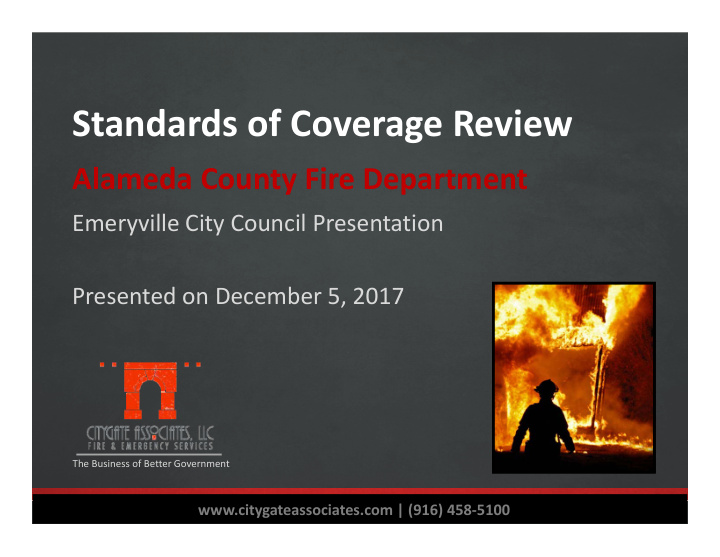



Standards of Coverage Review Alameda County Fire Department Emeryville City Council Presentation Presented on December 5, 2017 The Business of Better Government 11/29/2017 www.citygateassociates.com | (916) 458 ‐ 5100 1
Citygate’s Overall Opinion • The Fire Department provides advanced life support emergency medical care, but the threat of fire, even if low, still requires resources in addition to EMS hourly demand for an effective response to emerging fires • For its current risks and desired outcomes, the Alameda County Fire Department (ACFD) and Emeryville have the correct quantity of fire engines (pumpers) and quint/ladder trucks available in the urban areas that ACFD protects 2
Emeryville’s Current Deployment • Two fire engines staffed with six personnel in total • Automatic aid from Oakland – One engine and one ladder truck staffed with eight personnel in total – One Battalion Chief • Total initial staffing on an Emeryville structure fire response is 15 personnel, meeting best ‐ practice recommendations by the National Fire Protection Association (NFPA) Standard on Career Fire Departments 1710 and the advice of Citygate in urban areas 3
Risk Assessment Summary Planning Zone Risk Batt. 2 Batt. 3 Batt. 4 Batt. 7 Emeryville Castro Valley Dublin San Leandro Newark Cherryland Uninc. East San Lorenzo Union City 1 Building Fire MODERATE MODERATE MODERATE MODERATE MODERATE 2 Wildland Fire HIGH HIGH MODERATE HIGH LOW 3 Medical Emergency MODERATE MODERATE MODERATE MODERATE MODERATE 4 Hazardous Materials MODERATE MODERATE MODERATE MODERATE MODERATE 5 Technical Rescue MODERATE MODERATE MODERATE MODERATE MODERATE 4
Response Time Measure Advice • Best ‐ practice advice: – Total response time from fire dispatch receipt to unit arrival(s) – Measures and goals for dispatch, crew turnout, and travel time – Tied to risks and outcomes – Reflect population density and taxation economics • All of the above used by elected officials to set agency goals • Citygate tested urban response times from 9 ‐ 1 ‐ 1 receipt: – 1:30 dispatch + 2:00 crew turnout + travel (4:00 or 8:00 minutes) equals • 7:30 minutes for first ‐ due • For multiple unit responses, 11:30 minutes total response time for last ‐ arriving neighborhood ‐ based unit 5
Emeryville Contracted Response Times • 7:00 minutes, 90 percent of the time from dispatch to on scene • 11:00 minutes for multiple units, 90 percent of the time, including ACFD’s subcontract with Oakland – Oakland Fire Department (OFD) time is measured from fire dispatch receipt of 9 ‐ 1 ‐ 1 transfer 6
City of Oakland Contract • Oakland FY 17/18 cost: $182,063 • Oakland FY 18/19 cost: $187,525 • Oakland is obligated to respond as if incidents are within it’s City limits provided units are available to dispatch • OFD automatic aid into Emeryville: – 17 times FY 14/15 – 13 times in FY 15/16 – 13 times in FY 16/17 7
Call to First ‐ Unit Arrival Time – 2016 Best-Practice Urban Goal – 7:30 Minutes Area 2016 Department-wide 7:53 Battalion 2 – Castro Valley 7:43 Battalion 3 – Tri-Valley 8:09 Battalion 4 – San Leandro / Emeryville 7:39 #35 @ 7:52 Emeryville Only #34 @ 8:21 Battalion 7 – Newark / Union City 8:00 8
Travel Time – 2016 Best-Practice Urban Goal – 4:00 Minutes* Area 2016 Department-Wide 5:12 Battalion 2 – Castro Valley 5:01 Battalion 3 – Tri-Valley 4:58 Battalion 4 – San Leandro / Emeryville 5:00 #35 @ 6:21 Emeryville Dispatch to On-Scene #34 @ 7:05 Battalion 7 – Newark / Union City 5:31 * NFPA 1710 9
4:00 ‐ Minute Travel Time Coverage
8:00 ‐ Minute Travel Time Coverage for Three Engines
ACFD Overall Incident Statistics Summary • Incidents by time ‐ of ‐ day, day ‐ of ‐ week, and month follow typical urban area patterns • Incident volumes are typical, reflecting the demographics and population density • Daily demand of 117 incidents • 70.66 percent of the incidents are medical events • Fires account for 2.55 percent of all incidents • 26.79 percent are other types of emergency or public assist call • Incident quantities are steadily increasing but, at present, the units can handle more incident load 12
ACFD Incident Demand by Hour of Day 13
Overall ACFD Findings • Engine and ladder coverage is adequate • The travel time gaps that do exist are too small to justify additional fire stations • Limiting factor (outside of Emeryville) to improve First Alarm coverage is the locations of the Battalion Chiefs and, occasionally, ladder trucks • Risks and time ‐ of ‐ day volumes are not yet significant enough to warrant a different deployment plan for peak ‐ hour demands, even in Emeryville 14
Performance Recommendations for ACFD • Adopt best ‐ practice performance measures by the Board or Fire Commission to include all pieces of the response timeline: – 1:30 ‐ minute call processing time – 2:00 ‐ minute turnout time – 4:00 ‐ minute travel time – A total response time goal for first arrival of 7:30 minutes – Adopt an Effective Response Force goal of 11:30 minutes, 90 percent of the time 15
Overall ACFD Deployment Recommendations • Monitor workload increases per company at peak hours of the day and, if they reach an hour ‐ after ‐ hour level that significantly lengthens response times, then the ACFD should consider peak ‐ hour relief units primarily for the high volume of EMS calls for service • Emeryville must maintain multi ‐ unit support from Oakland given ACFD’s other locations 16
Overall ACFD Next Steps • Absorb the policy recommendations of this fire services study and ask the Board or Fire Commission to formally adopt ACFD response time measures • Monitor the impact of incident growth and traffic congestion on individual fire companies at peak hours • If simultaneous incident demand and/or traffic congestion continues to decay response times, additional stations, or peak ‐ hour engines, will become necessary to maintain response times to critical events 17
Questions? 18 18
Recommend
More recommend